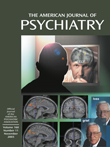In Search of the Emotional Self: An fMRI Study Using Positive and Negative Emotional Words
Abstract
OBJECTIVE: The authors used functional magnetic resonance imaging (fMRI) to define the neural regions mediating self-referential processing of emotional stimuli and to explore how these regions are influenced by the emotional valence of the stimulus. METHOD: Ten healthy subjects were presented with words describing positive and negative personality traits during fMRI scanning in three different conditions. In the self-referential processing condition, subjects judged whether they thought each trait described them. In the other-referential processing condition, subjects judged whether the stimulus described a generally desirable trait. In the letter-recognition control condition, subjects indicated whether the word contained a specific target letter. RESULTS: The self-referential condition induced bilateral activation in the dorsomedial prefrontal cortex, whereas the other-referential condition induced activation in lateral prefrontal areas. Activation in the right dorsomedial prefrontal cortex was unique to the self-referential condition regardless of the valence of the words, although positive words produced a more robust activation than did negative words. In the self-referential condition, differences between the processing of positive and negative words were seen in regions outside the medial frontal cortex, with reductions in the insula, temporal and occipital regions, and inferior parietal regions associated with negative words. CONCLUSIONS: A widely distributed network of brain areas contributes to emotional processing. Among these regions, the right dorsomedial prefrontal cortex is one main area mediating self-reference. By providing a personal perspective in the evaluation of emotional stimuli, the right dorsomedial prefrontal cortex may mediate cognitive processes, such as those involved in psychotherapy, that guide self-regulation of emotional experience.



